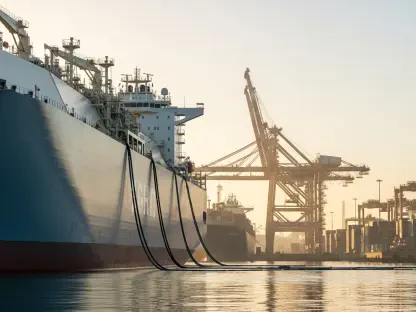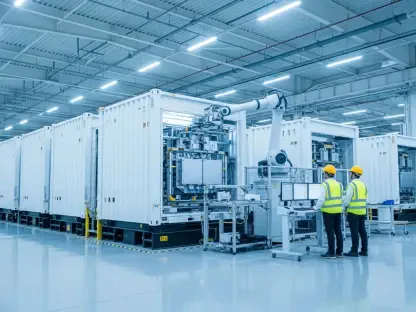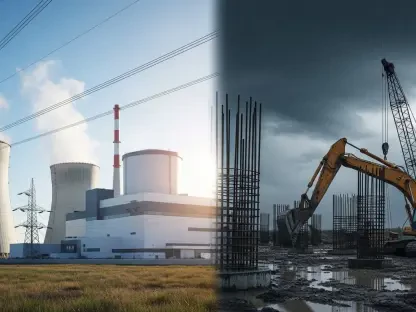In a world where global trade tensions often dictate corporate fortunes, Siemens Energy stands as a striking exception, navigating the choppy waters of U.S. import tariffs with remarkable agility. Picture a powerhouse in the energy sector, generating a fifth of its revenue from the American market, yet refusing to buckle under financial pressures that might sink lesser competitors. As of 2025, this German giant is not merely surviving but surging ahead with record-breaking orders and growth forecasts. What fuels this resilience in the face of geopolitical headwinds? The answer lies in a blend of strategic foresight and market dominance that demands closer examination.
The significance of this story extends beyond a single company’s success. Siemens Energy’s ability to thrive amid tariffs offers a critical lens into the broader challenges and opportunities within the global energy sector. With the United States imposing substantial duties on imports, many firms face profit squeezes and operational hurdles, yet Siemens Energy’s performance signals a potential blueprint for others. This narrative unpacks how a titan of industry turns adversity into advantage, providing insights that resonate across markets and borders.
Why Tariffs Fail to Dim Siemens Energy’s Momentum
Despite the shadow cast by U.S. import tariffs, Siemens Energy continues to post extraordinary growth, defying expectations that such trade barriers would stifle progress. The company has absorbed a notable hit to profits—around 100 million euros ($116 million) in the fiscal year to date as of recent reports, with further impacts anticipated. Yet, this financial burden has not derailed its trajectory, as robust market dynamics and internal strategies keep the firm on an upward path.
A key factor in this resilience is the sheer scale of Siemens Energy’s operations and its entrenched position in critical energy markets. The U.S., a cornerstone of its revenue stream, remains a hotbed of opportunity despite tariff-related costs. This paradox highlights a broader reality: when a company’s offerings are indispensable, even significant external pressures can be navigated with relative ease, setting Siemens Energy apart from peers struggling under similar constraints.
The Broader Impact of U.S. Tariffs on Energy Giants
U.S. import tariffs, initially ramped up under past administrations, have created a complex landscape for global energy firms, reshaping cost structures and competitive dynamics. For a company like Siemens Energy, with deep ties to the American market, these policies translate into tangible profit impacts that require careful management. The stakes are high, as the energy sector often operates on thin margins where additional costs can disrupt long-term planning.
Beyond immediate financial effects, these tariffs signal a shift in global trade relationships, affecting how companies strategize their supply chains and market approaches. Siemens Energy’s experience serves as a litmus test for the industry, illustrating the ripple effects of geopolitical decisions on operational realities. As duties continue to influence pricing and profitability, the firm’s response offers a glimpse into how adaptability can mitigate even the most daunting trade challenges.
Siemens Energy’s Blueprint for Success in a Tariff-Laden Market
Siemens Energy’s ability to excel despite tariff pressures rests on several strategic pillars that have fortified its market standing. Strong demand in the U.S. for gas turbines and power transmission equipment has propelled the company toward the upper end of its sales growth forecast of 13-15%, with a staggering order backlog of 136 billion euros reported in recent quarters. This surge underscores an unyielding appetite for the company’s solutions, cushioning the blow of external financial hits.
Another linchpin of success lies in contractual innovations that shield the firm from tariff impacts. Newer agreements incorporate cost pass-through mechanisms, allowing Siemens Energy to share the burden of duties with clients, a move that has minimized the profit dent—previously estimated at 100 million euros—from older, less flexible contracts. CEO Christian Bruch has emphasized that as these outdated deals phase out, the tariff sting will lessen, paving the way for smoother financial sailing.
Equally compelling is the company’s recovery from past turbulence, notably a wind turbine quality crisis that once threatened its stability. Bolstered by German government guarantees, Siemens Energy has staged a remarkable turnaround, with its share price nearly doubling since early 2025 and dividends resuming ahead of schedule. This rebound showcases a capacity to transform setbacks into stepping stones, reinforcing investor confidence amid ongoing trade frictions.
Leadership Perspectives and Market Validation
Insights from Siemens Energy’s leadership paint a picture of calculated optimism in navigating tariff challenges. CEO Christian Bruch has described these trade duties as “manageable,” stressing the centrality of the U.S. market to the company’s global strategy. His confidence is not mere rhetoric but grounded in a belief that strategic adjustments and market demand will continue to outweigh temporary financial pressures.
This perspective is echoed by tangible market indicators that affirm Siemens Energy’s standing. Third-quarter orders skyrocketed to 16.6 billion euros, surpassing analyst predictions of 14.1 billion euros, a clear signal of customer and investor trust. Such figures validate the leadership’s outlook, demonstrating that the company’s direction resonates with stakeholders even as trade policies test its mettle.
Key Takeaways from Siemens Energy’s Tariff Navigation Tactics
Siemens Energy’s approach offers valuable lessons for businesses grappling with similar trade barriers in volatile markets. One critical strategy is leveraging high-growth areas to offset external costs—identifying regions or product lines with robust demand can create a buffer against tariff impacts. For other firms, this might mean doubling down on markets where their offerings are in high demand, mirroring Siemens Energy’s focus on the U.S. energy sector.
Another actionable insight is the importance of evolving contract structures to distribute financial risks. Transitioning to agreements that allow cost-sharing with clients can significantly reduce the burden of duties, a tactic that has proven effective for Siemens Energy in recent dealings. Companies across industries might consider renegotiating terms to build similar flexibility into their operations.
Lastly, building operational resilience through partnerships and recovery mechanisms stands out as a cornerstone of enduring success. Siemens Energy’s collaboration with government entities during crises highlights the value of external support in stabilizing operations. Businesses facing trade headwinds should explore alliances or contingency plans that ensure stability, taking a page from this energy giant’s playbook to secure long-term growth.
Reflecting on a Path Forged Through Challenges
Looking back, Siemens Energy’s journey through the maze of U.S. tariff challenges stands as a testament to strategic ingenuity and market acumen. The company weathered profit hits and trade uncertainties with a blend of demand-driven growth and adaptive contracting, setting a high bar for industry peers. Its story unfolds as one of resilience, where obstacles become opportunities through deliberate and forward-thinking actions.
As industries continue to grapple with global trade dynamics, the next steps for companies inspired by this example involve a deeper assessment of market needs and contractual agility. Exploring untapped demand pockets and forging partnerships to mitigate risks emerge as vital strategies. Siemens Energy’s experience underscores that thriving amid adversity requires not just reaction, but proactive reinvention—a lesson that echoes far beyond the energy sector.









